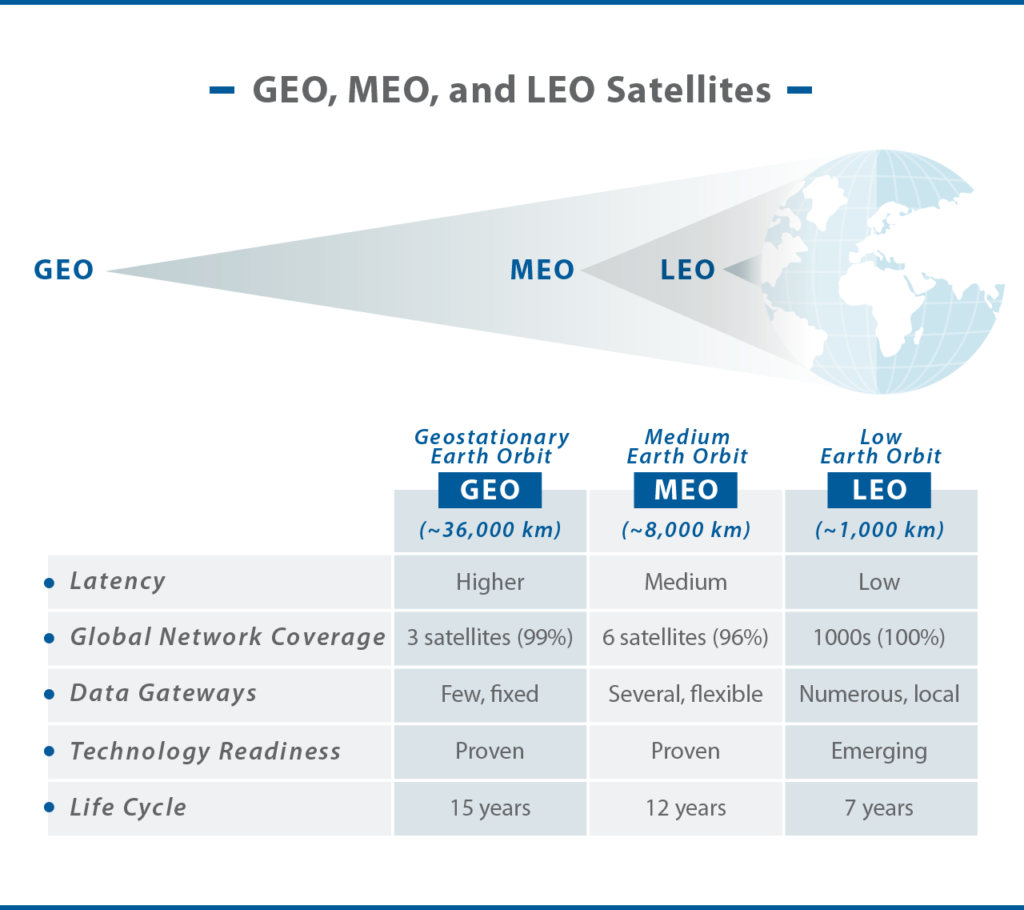Introduction
Future military operations between peer competitors will be characterized by Multi-Domain Operations (MDO) approach, which will feature the integrated and parallel use of Air, Sea, Land, Cyberspace and Space. Across the spectrum of military operations, from low-tempo peace-keeping missions and security force assistance to high-intensity, high-tempo warfighting operations, the military will make use of all operational domains—but particularly the space domain. Space has become vital to modern military activity as the speed and tempo of operations have increased and led to compressed time-cycles for decision-making at the command and control (C2) and tactical levels.
In addition, military activity is more closely scrutinized today given the accelerating and widening access to open-source information in the public domain among civil society actors. One consequence of this has been to intensify the need for more rapid but also more accurate intelligence to inform decision-making in military campaigns. Information from an expanding set of sources and origins has become the ways and means for decision-making and the space domain has figured centrally to this evolution of military planning and operations across the range of missions that militaries are expected to routinely undertake.
The space domain is the only way to ensure continuous, cross-border intelligence and situational awareness today and facilitate vital communications. This reality necessitates greater attention to be focused on the security of space assets and capability planning for space applications in the future. As it stands, the space domain still does not garner the strategic attention around the world that it already warrants. However, the military’s use of space will not only remain on the agenda of defense organizations and military capability planners for years to come but will increase in importance.
The Geopolitics of Earth, Space and the Widening Threat Spectrum
It could be argued that as far back as World War II, the use of space was witnessed in warfighting when Germany lobbed V2 rockets with ballistic trajectories towards Britain. In more recent times, the first military campaign where the space domain played a crucial role occurred during the First Gulf War in 1991. Without the use of satellite-enabled GPS, which provided precision navigation and targeting for kinetic effects and space-based observation of the conflict theatre for situational awareness, the US and its coalition partners may not have achieved the same outcomes of Operation Desert Storm that they did.
Since the end of the First Gulf War, Western militaries have gradually expanded their use and efforts in leveraging the space domain as a way to introduce operational advantages. This growing dependency or addiction on the space domain has however also created—and enlarged—new types of vulnerabilities for military operations which opponents are increasingly capable of exploiting. In this emerging context it is vital that militaries begin to refocus attention on their use of space in terms of planning and developing space capabilities relative to emerging new threats and strategic vulnerabilities.
This is a challenge that needs to be undertaken at a time when few can doubt that great power competition is back on the global stage. As global dynamics have evolved, the United States has been rebalancing its global posture with a pivot to Asia. Falling energy reliance on the Middle East for the United States has also triggered discussion around its long-term regional role. For Europe, any future unrest and instability from its eastern and southern borders may lead to unprecedented challenges with refugees and displaced persons. In managing the security impact of such risks, European militaries could well face a new reality where reliance on or the availability of American space assets cannot be taken for granted.
At the same time, Europe’s own resolve for strategic autonomy and sovereignty may grow stronger and extend to its future space strategy. Geopolitical factors and lower barriers of entry are likely to continue introducing new players into the frame, pursuing the strategic and tactical use of space, operating satellites and developing ground-based enabling infrastructure. Whilst space cannot be divided into civilian and military spaces, the area of ‘military space’ will feature the traditional powers of US, Russia and China but also see the addition of new players such as the European Union (EU), India, the UAE and others.
The risks of using and reliance on space for military operations are increasing rapidly as the number of space actors expands. Congestion is a serious threat in space, particularly in Low Earth Orbit (LEO)—the altitude which spans 400-1500 km above the earth—where satellites risk becoming obliterated. LEO is becoming saturated not only by military users but also a growing range of commercial operators producing and launching high numbers of small satellites to serve the rapidly growing commercial space industry.

The risks of growing space congestion are real—since the widely studied collision of Iridium-33 and Kosmos 2251 in February 2009, in March 2021, the collision between Yunhai 1-02 and the fragments (also the result of a knock-off) from Russia’s Zenit-2 rocket, which itself was launched in September 1996, reinforced the risks to satellite operations. These recent collisions were most probably accidents but close proximity maneuvers by satellites towards other satellites have been observed recently and such close encounters can be the result of offensive intent designed to render satellites unreliable, untrustworthy or even completely unusable.
Securing data and information flows through optical communication, cryptology, frequency hopping or pinpointed radio transmission will need to feature as vital a capability design parameter.
– Patrick Bolder
Recently observed close proximity encounters and operations do not appear to have inflicted any visible damage but these incidents have triggered military actors in space to rethink their postures and consider mechanisms for enhancing the protection of their assets—including, potentially, through weaponization. In December 2019, NATO explicitly acknowledged space as a military operations domain. Anti-satellite (ASAT) weapons are known to have been experimented with widely and are likely to be developed more readily as a way to introduce the logic of deterrence and denial into the space domain against opponents which may seek to exploit legacy space system vulnerabilities.
There are major implications for such trajectories because of the unintended consequences and secondary effects such developments would generate at the lowest level, simply through the risk of space debris spreading across significant swathes of space. Opponents in space will also seek to target the critical communications relays between satellites and supporting ground infrastructure or command centers. Technologically less advanced opponents could attack or disrupt ground-based infrastructure supporting space operations such as by simply denying physical access, cutting power cables or even physical attacks and destruction.
The widening spectrum of threats in space are not all-encompassing—for the time being, these mainly relate to space assets in LEO. Here, there are a series of defensive responses from military planners available which focus on the LEO environment—for example, the hardening of supporting and enabling terrestrial infrastructure, earth-to-space (and vice versa) communication channels and also space-based assets themselves. Additionally, military planners will need to generate new ways and means for improved space situational awareness, space traffic management, maneuverability in space, responsiveness and payload adaptability as well as, crucially, international cooperation and efforts towards creating a rules-based order in space.
Terrestrial, Communications and Satellite Hardening
The easiest ways for opponents to target space capabilities supporting military operations is to focus on the terrestrially-based supporting and enabling infrastructure. Fortunately, these elements of space capability are the easiest to defend and, if necessary, repair or replace. Whilst this may initially seem a less sophisticated and low-cost response to reducing vulnerabilities for military space operations, it is vital to not allow this element of future space power and capability planning to escape the strategic design and planning process.

As cyberspace meets space, a dual vulnerability is introduced, particularly for military communications. The command and control (C2) and information channels between ground and space-based assets are highly sensitive to spoofing, disturbance, jamming and other forms of interference. Securing data and information flows through optical communication, cryptology, frequency hopping or pinpointed radio transmission will need to feature as vital a capability design parameter.
The widening spectrum of threats in space are not all-encompassing—for the time being, these mainly relate to space assets in LEO.
– Patrick Bolder
Satellites are also increasingly likely to themselves become the subject of offensive maneuvers and actions to render them less useful or even useless. Military actors in space must begin to consider and address how space-based assets will be protected against physical attacks, exposure to high energy radiation, electromagnetic tampering and a range of emerging new threats from earth. Special coatings and layers, sensors that detect tampering and the enhancement of defensive and appropriate countermeasures will need to be developed and implemented.
Improved Space Situational Awareness (SSA), Space Traffic Management and Maneuverability
SSA underpins an accurate real-time picture of the space domain and makes possible insights into unexpected or unusual occurrences. With SSA, satellite operators can better monitor and control the proximity of their assets to potential threats and collision risks—particularly as it applies to navigating space debris in LEO. The necessary configuration of sensors and data processing technologies will be able to provide early warning against the possible intrusion of satellite safe bubbles as well as make attribution possible. In the emerging scenario, deniability of offensive maneuvers and actions will be out of the question as accurate attribution is made possible and, logically, a more robust model of deterrence can be enforced.
By making possible a more accurate picture of space and proximity calculations, it will become possible to determine appropriate actions to consider and pursue in more timely ways as well as effectively developing a space traffic management system. Improved SSA will lead to the reduction of a satellite’s safe bubble as it is constituted and in turn this will reduce the propensity for evasive maneuvering while offering safer ways to achieve and maintain safe navigation and mobility in space. By also enabling space traffic management, the security of space-based systems will be enhanced, prolonging satellite lifespans and support better planning for replacements, upgrades and new insertions.
Enhancing the maneuverability of satellites is an imperative defensive measure to enhance their protection and survivability. The same benefit of maneuverability as it applies to ground units where mobility will enhance the protection but where a more complex set of challenges will need to be addressed, such as fueling, on station-time and tactics, techniques and procedures (TTPs).
Design, Responsiveness and Payload Adaptability
In the event of losing satellites as a result of offensive actions by an opponent or natural circumstances and even accident, it will be critical to replace any lost capability in the shortest time possible—with a like-for-like or improved system. Indeed, the future of satellites lies with micro or nano-satellites which are less costly to build and launch in comparison to legacy space systems. Where the need for new functionalities and requirements emerge, new space technologies will create new ways to deliver these in more responsive ways. Responsiveness in design, manufacture, testing, procedures and launch will need to be key criterions for space capability planning and will need to be supported by close and continuous cooperation with industry and knowledge partners.
In the design of new satellites and space systems, the development of new applications may need to be spread out in order to build and launch satellites more rapidly and cost effectively. Implementing new and constantly evolving requirements through development programs is unreasonable and militaries must become better at pushing these towards future iterations. Constant change and modifications to space development programs can add huge cost and time delays. Instead, the focus must be on making satellites more modular or adaptable so that their functionality can be modified without great cost or complexity. If high modularity and adaptability is built into the current generation of satellites under development, their usability and lifespans would be enhanced enormously.
Geopolitical factors and lower barriers of entry are likely to continue introducing new players into the frame, pursuing the strategic and tactical use of space, operating satellites and developing ground-based enabling infrastructure.
– Patrick Bolder
International Cooperation and a Rules-Based Order in Space
For smaller militaries and particularly those which cooperate under a common security umbrella, burden-sharing through a division of responsibilities and capabilities is strategically compelling. The pooling and shared use of assets and capabilities will be a crucial feature of developing space capabilities that will rest on successful outcomes in international cooperation. International cooperation regarding the use of space will also need to address the wide range of freedom that currently exists for any actor in space in the absence of rules on behavior. Until now it appears that the limited number of nations with advanced space capabilities have been reluctant in creating more concrete frameworks and developing long-term rules between themselves to avoid hampering the future range of strategic possibilities. Yet with increasing congestion in LEO, the emergence of new military actors in space and its evolution as a contested operational domain, space should no longer be accessed and exploited in the absence of a minimum set of rules and acceptable risk.
Conclusion
The widening spectrum of threats—increasingly cross-domain in nature—and the acceleration in military decision-making required given massive increases in data produced or becoming available exacerbates future challenges for warfighters. Hybrid warfare and military competition below the threshold of open conflict will need systems which support the military planners and operators with early warning, superior situational awareness and prompt decision-making. Rapid access to information where integrity is guaranteed will be crucial to strategic success. Across all of these strategic imperatives, the space domain will have a vital role to play.
Access to the space domain comes with enough challenges on its own but in the context of the military use of space, even more must be considered. Nonetheless, dependency on and use of the space domain is inescapable and capability planning for it must apply fundamental considerations for delivering technical solutions which generate new strategic and operational advantages and by forwarding the goal of international cooperation to allow the unobtrusive use of space. Ultimately, though, it should not be lost on militaries to think about how the loss of access to critical space infrastructure will be negotiated. At a time where access to space is taken for granted, the military arts of map and compass reading, field orientation, navigation and operating without communications may need to be preserved for longer yet.








